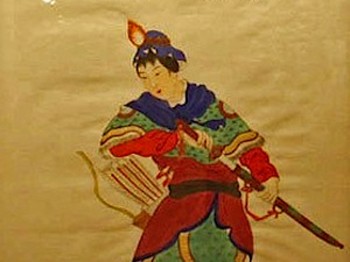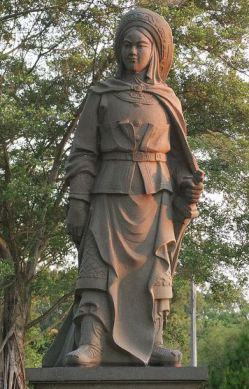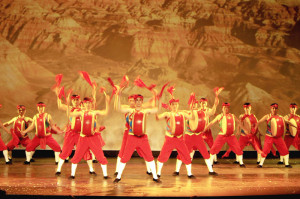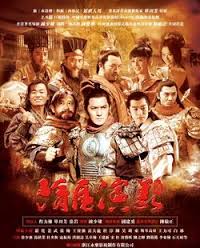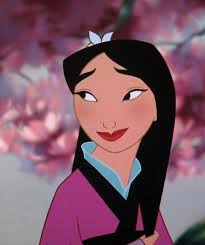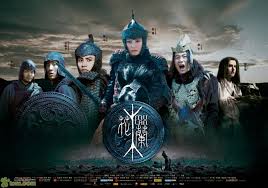With the announcement that Disney will begin making a new, live-action Mulan, I thought now would be a good time to talk about ‘the real Mulan,’ who has appeared in Chinese literature for centuries. She’s been a favorite subject of playwrights, poets and novelists since the 6th century, each of whom have added their own twists and flourishes. Because Mulan mostly appears in works of fiction, the question must be asked – was she a real person?
To which this blog answers: it doesn’t matter. Chinese artists thought her story important enough to keep it alive for millennia; so it’s worth telling. And storytellers often draw on real-world events for their inspiration. So it’s quite likely that, at some point, a story like Mulan’s really did happen.
This is much shorter that last week’s entry, and mostly summarizes three works in which Mulan appears prior to her Disneyfication!
6th Century Version
The original Ballad of Mulan is extremely short – only a few dozen lines. Mulan sits weaving at her loom, but she’s crying so loudly that her sobs drown out the clacking of the shuttle. Her parents, thinking she must be lovesick, ask her who she’s thinking of. Mulan answers she is only thinking of her father, and how she saw his name on a list of soldiers expected to report soon for military duty. She knows her parents are both old; her father will not survive an extended military campaign. So she decides to take his place.
After buying some gear at the market, she travels quickly to join up with the army. She stays a soldier for ten years, finally returning home in triumph. There, she is personally greeted and rewarded by the Emperor for her valor. He gives her a significant promotion, some treasure and asks what else she’d like. Mulan could have asked for a government job, or more treasure, but instead just asks for a fast horse so she can return home quickly.
She travels with some army buddies going in the same direction, and her family is thrilled to see her again. Her parents are still alive, and they have a party to celebrate! Mulan, for her part, takes off her armor and puts on some makeup and feminine clothes. This, of course, absolutely stuns her army buddies; but Mulan basically comments that, when a rabbit is doing its thing and hopping around, you can’t tell if it’s male or female (I think this might be a Chinese ‘army joke’ that goes over my head).
15th Century Version
Sometime during the late Ming dynasty, the playwright Xu Wei used Mulan as inspiration for the play The Heroine Mulan Joins the Army in Place of her Father. Wei expands on the ballad, adding in some details here and there but largely keeping the rough shape of the original ballad.
In the play, the conflict which spurs the draft is the rise of a bandit leader named Leopard Skin. Mulan has received some basic martial arts training already, and specifically asks her parents for permission before leaving. Her mother is hesitant to let Mulan go, but eventually relents.
Mulan is quickly accepted into the ranks, and distinguishes herself to the extent that her commanding officer orders her to be the one to capture Leopard Skin. This she does, barely breaking a sweat before Leopard Skin is bundled off to go stand trial.
Mulan is again rewarded, and again thinks only of returning home. Once there, the happy reunion is made doubly so by the fact that Mulan’s mother has thoughtfully arranged a very good marriage for her daughter while she’s been away, which Mulan gratefully accepts.
She does experience some identity crises while on stage – she wonders if ‘she’ has really done all these heroic things, or if it’s simply her male alter ego who is the real hero. These issues don’t necessarily get resolved, as Mulan goes back to the life of a traditional Chinese woman once the war is over.
17th Century Version
A thousand years after the first ballad, another Chinese artist, Chu Renho, wrote an epic historical fiction titled Sui Tang Yanyi (Romance of the Sui and Tang Dynasties), which tells the stories of the the Sui and Tang Emperors of the 6th-9th centuries. In this work, Mulan has a small cameo during a peasant rebellion (to put this into modern context, her role is roughly equivalent to Edmure Tully from Game of Thrones: he shows up in an important episode or two, but the story quickly moves on).
Mulan, in this story, is the daughter of a Mongolian father and Han Chinese mother, living under the rule of a Mongol khan. According to Renho, it’s the khan who drafts Mulan’s father to go fight the rising Tang emperors. Mulan finds herself caught up in a peasant rebellion, gets captured, and is promptly taken in for questioning by the leader’s military-minded daughter, Xianniang.
Xianniang quickly uncovers Mulan’s secret, and is delighted to discover another woman in armor. She and Mulan quickly become sworn sisters. However, the Emperor defeats Xianniang’s father, and he is sentenced to die. But Mulan and Xianniang intercede, offering themselves up in his place. The Emperor is so moved by their filial piety that he pardons all three of them, and allows Mulan to return home so she can collect her parents and move everyone to the capital city.
This story ends sadly, though: when Mulan returns home, she discovers that her father is dead and her mother has remarried. Even worse, the khan under which her father lived has summoned Mulan to come be his concubine. Mulan, rather than submitting, chooses to kill herself.
Mulan in Modernity
Apart from her appearances noted here and elsewhere, Mulan has been the topic of Chinese film since the silent film era. And after the Disney version came out, Chinese filmmakers responded with their own retelling, a live-action film called Mulan: Rise of a Warrior.
In 1975, noted academic and writer Maxine Hong Kingston included the story of ‘Fa Mu-Lan’ in her semi-autobiographical, English-language work, The Woman Warrior. Kingston blends traditional Chinese legend with stories from her upbringing as a first generation Chinese-American. Her treatment of Mulan in the book has been criticized for being overly fanciful, but Kingston was instrumental in introducing Mulan to a Western audience.
Mulan’s story gained global notoriety in 1998, when Disney made their film. She has continued to pop up in other Disney properties (Mulan has a few brief appearances as a companion to Prince Phillip and later Aurora in the live-action TV show Once Upon a Time), and she’s made an appearance in other Western stories.
She also has a crater on Venus named after her!
Epilogue
Though there may once have been a woman who took her father’s place and enjoyed a successful military career as a result, it quickly becomes apparent that the figure of Mulan in popular Chinese culture is more literary than historical. Whoever the ‘real Mulan’ might have been, her legacy has been to become an archetypal character in the literature of her culture.
With that in mind, it’s important to view the story of Mulan in it’s full context. A common theme in many Chinese stories is the extreme lengths to which the younger generation will go to please their parents. Mulan defies the gender restriction placed on military service, but she does so serving a higher cultural value: protecting her father and ensuring his comfort in old age. She doesn’t join the army out of personal ambition or desire, but filial piety and duty. Once that duty has been discharged, she re-assumes her traditional feminine role. As such, it’s inaccurate to view Mulan as a subversive figure.
This in no way diminishes any of her accomplishments or bravery; but rather is meant to illuminate her motivations. Western culture prizes ambition and individual achievement for it’s own sake; Disney’s Mulan is an unhappy, rebellious teenager who runs away in part to find self-actualization. Which doubtless made her a relatable character to other unhappy American teenagers… but we should be careful not to project Western values on Mulan. In Chinese literature, Mulan sets the example of a woman who follows her duty, accomplishes great things as a result, and returns home to live a happy, quiet life as her reward.
Resources
The Ballad of Mulan, 6th Century
Mulan: Five Versions of a Classic Chinese Legend, With Related Texts
The Woman Warrior by Maxine Hong Kingston
